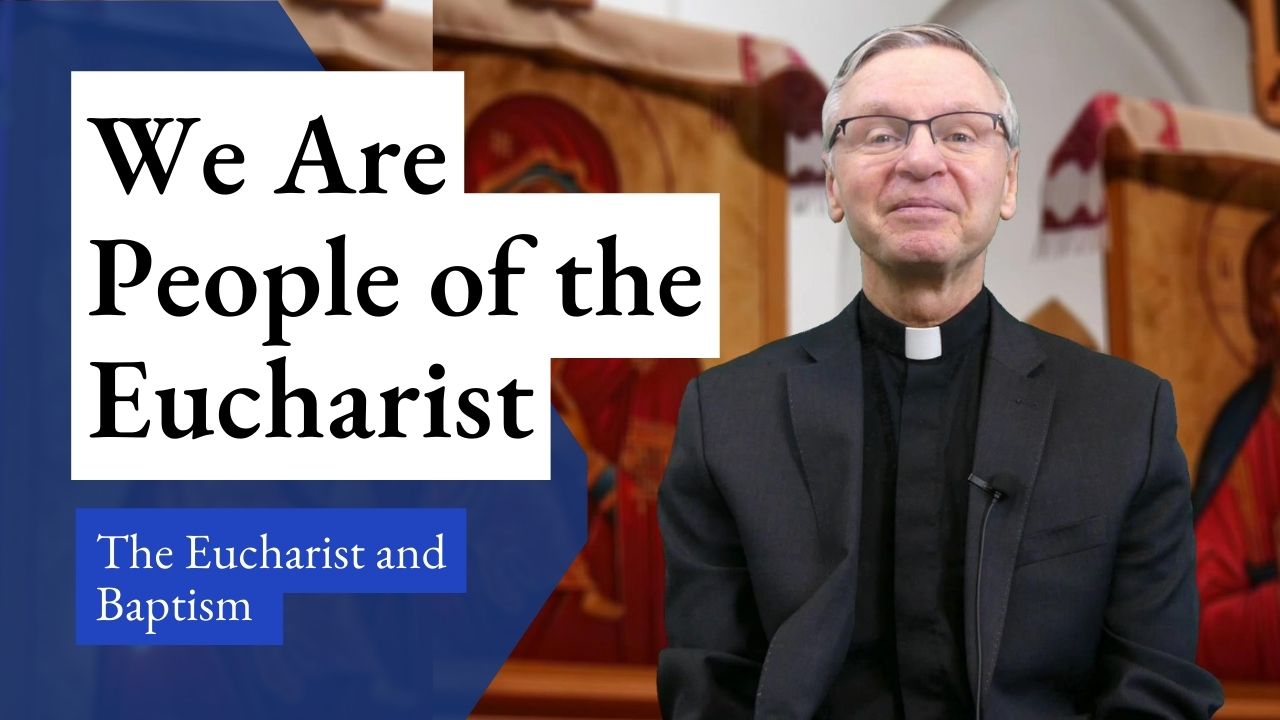We Are People of the Eucharist
Towards a renewed love for Holy Communion
Reflections on the Eucharist
by Bishop David Motiuk, Eparchy of Edmonton
November 2023
The Eucharist and Baptism – From Rags to Riches
In the early Church, when people became members of the Body of Christ, they were fully initiated, that is, they received at one and the same time the mysteries (sacraments) of baptism, chrismation (confirmation), and Holy Communion.
As the 1996 Eastern Liturgical Instruction teaches us: “Initiation is, in reality, the one and indivisible celebration of the entrance into the life of Christ, into the community that lives in him. This entrance, initiated with the first call to the faith reaches its culminating point in the Paschal Mystery of Christ, in whose death we are immersed to be raised in his resurrection which renders us children of God and the temple of the Spirit. ‘Anointed’ by the Spirit for the work of the Kingdom, we are thus rendered fit to participate in the banquet of the Kingdom [Divine Eucharist]” (paragraph 42).
The Instruction continues: “In Baptism, the person is freed from sin, reborn to new life, reclothed in Christ and incorporated in the Church. In Chrismation with the holy Myron [myrhh], he or she is signed with the seal of the gift of the Holy Spirit. The full initiation is made final by the reception of the Eucharist, a sacrament not only of the communion of the individual with Christ, Head of the Mystical Body, but also of the communion among all the faithful, members of the Body who live the new life in Him. The nourishment of the Body and the Blood of the incarnated Word brings the Christian to perfection, in such a way that it is no longer he that lives but Christ that lives in him” (paragraph 43).
With this teaching in mind, let us reflect further on our baptism, which leads us by the grace of the Holy Spirit to the Eucharistic Table.
Did you know that for the first three centuries, Christians did not have a separate feast for Christmas? Rather, they celebrated both the Nativity and Baptism of Our Lord on January 6.
Only in the fourth century did the Roman Church first begin celebrating Christmas on December 25. It did so in order to replace the pagan feast of the Sun-god, regarded as the birthday of the sun and its triumph over the darkness of the night. Christian Rome eventually substituted the pagan Sun-god with its Christian Sun-the God-Man and began celebrating Jesus’ birth on December 25.
In time, the Eastern Christian Churches followed, but continued to celebrate Jesus’ baptism on January 6, and do so even day.
Baptism. Swaddling clothes. Burial robes.
When Jesus was born, Mary and Joseph wrapped him in swaddling clothes and laid him in a manger.
What are swaddling clothes?
Well, when a baby is born, hospitals use a cloth sometimes called “swaddling” cloth to wrap the newborn. However, contrary to popular belief, tradition has it that swaddling cloth had more to do with death than birth.
In the Middle East, when people travelled long distances oftentimes through hardship, they carried with them thin, gauzelike cloth to wrap the body of a loved one in preparation for burial should someone have died during the long journey.
When Jesus was born in a stable, for there was no room in the Inn, Mary and Joseph used swaddling cloth to wrap him, cloth usually reserved for someone’s death.
And they weren’t far off. After all, Jesus was born in order to die. To die for our sins and our salvation.
At Jesus’ death, after his crucifixion and passion upon the Cross, we see these same swaddling clothes. Joseph of Arimathea went to Pilate and asked him for Jesus’ body. “They took the body of Jesus and wrapped it with the spices in linen cloths, according to the burial custom of the Jews” (John 19: 40).
At our baptism, we are given new clothes, a new white robe to signify that we have been washed clean of sin and have been given new life. Saint Paul puts it this way: “Do you not know that all of us who have been baptized into Christ Jesus were baptized into his death? Therefore we have been buried with him by baptism into death, so that, just as Christ was raised from the dead by the glory of the Father, so we too might walk in newness of life” (Romans 6: 3-4).
Old rags just won’t do! At baptism they were thrown away. After all, we have entered a Kingdom, the Kingdom of God. The King of King himself awaits us and welcomes us. And he says, “What fine robes you are wearing!”
Let us remember that even in his birth, Jesus was already preparing for his death.
In our re-birth through baptism, each day we can add to the brilliance of our new clothes, one stitch at a time, through prayer, a kind word, love and forgiveness. We do want to be properly dressed in our finest robes when we fully enter the Kingdom and meet God face to face.
From rags to riches.
We are people of the Eucharist.

